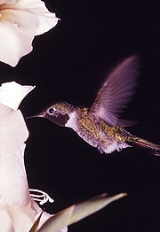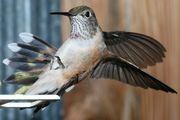
Broad-tailed Hummingbird
Encyclopedia
The Broad-tailed hummingbird, Selasphorus platycercus, is a medium-sized hummingbird
, nearly 4 in (10.2 cm) in length.
 Male and female both have iridescent green backs and crowns and a white breast. The male has a gorget
Male and female both have iridescent green backs and crowns and a white breast. The male has a gorget
(throat patch) that shines with a brilliant red iridescence. The female is much duller with rust-colored, mottled flanks and underside; her tail feathers are tipped with a band of white. In flight the male's wings produce a distinct trilling sound diagnostic for this species
.
The summer range of the Broad-tailed Hummingbird extends across mountain forests and meadows throughout the Western United States
, specifically the Great Basin
region and southwards; the resident birds range from the cordilleran mountain areas of northern Mexico
as far south as Guatemala
. At summer's end the northerly birds migrate
and overwinter
in the southern part of their range. This species is somewhat vagrant, especially wintering birds, and is regularly seen in El Salvador
where it does not breed. They occur at altitudes ranging from 700–900 m (2,296.6–2,952.8 ft) up to 3350 m (10,990.8 ft) ASL
in the tropical parts of their range.
Aside from the typical hummingbird diet of nectar and insects found at flower blossoms, the Broad-tailed Hummingbird will also actively hunt insects, both in flight and on foliage. This species is not considered endangered; it appears to be able to adapt quite well to human-modified habitat and frequents shade coffee plantation
s.
 Nests are small cup of plant fibers woven together and bound to a branch with collected spider webs. The female lays two plain white eggs, that she alone will incubate for 16 days. Young Broad-tailed Hummingbirds fledge
Nests are small cup of plant fibers woven together and bound to a branch with collected spider webs. The female lays two plain white eggs, that she alone will incubate for 16 days. Young Broad-tailed Hummingbirds fledge
about 23 days after hatching. This species is known to hybridize with Costa's Hummingbird
, but apparently only very rarely.
Hummingbird
Hummingbirds are birds that comprise the family Trochilidae. They are among the smallest of birds, most species measuring in the 7.5–13 cm range. Indeed, the smallest extant bird species is a hummingbird, the 5-cm Bee Hummingbird. They can hover in mid-air by rapidly flapping their wings...
, nearly 4 in (10.2 cm) in length.

Gorget (birds)
A gorget is a patch of colored feathers found on the throat or upper breast of some species of birds. It is a feature found on many male hummingbirds, particularly those found in North America; these gorgets are typically iridescent. Other species, such as the Purple-throated Fruitcrow and Chukar...
(throat patch) that shines with a brilliant red iridescence. The female is much duller with rust-colored, mottled flanks and underside; her tail feathers are tipped with a band of white. In flight the male's wings produce a distinct trilling sound diagnostic for this species
Species
In biology, a species is one of the basic units of biological classification and a taxonomic rank. A species is often defined as a group of organisms capable of interbreeding and producing fertile offspring. While in many cases this definition is adequate, more precise or differing measures are...
.
The summer range of the Broad-tailed Hummingbird extends across mountain forests and meadows throughout the Western United States
Western United States
.The Western United States, commonly referred to as the American West or simply "the West," traditionally refers to the region comprising the westernmost states of the United States. Because the U.S. expanded westward after its founding, the meaning of the West has evolved over time...
, specifically the Great Basin
Great Basin
The Great Basin is the largest area of contiguous endorheic watersheds in North America and is noted for its arid conditions and Basin and Range topography that varies from the North American low point at Badwater Basin to the highest point of the contiguous United States, less than away at the...
region and southwards; the resident birds range from the cordilleran mountain areas of northern Mexico
Mexico
The United Mexican States , commonly known as Mexico , is a federal constitutional republic in North America. It is bordered on the north by the United States; on the south and west by the Pacific Ocean; on the southeast by Guatemala, Belize, and the Caribbean Sea; and on the east by the Gulf of...
as far south as Guatemala
Guatemala
Guatemala is a country in Central America bordered by Mexico to the north and west, the Pacific Ocean to the southwest, Belize to the northeast, the Caribbean to the east, and Honduras and El Salvador to the southeast...
. At summer's end the northerly birds migrate
Bird migration
Bird migration is the regular seasonal journey undertaken by many species of birds. Bird movements include those made in response to changes in food availability, habitat or weather. Sometimes, journeys are not termed "true migration" because they are irregular or in only one direction...
and overwinter
Overwinter
To overwinter is to pass through or wait out the winter season, or to pass through that period of the year when “winter” conditions make normal activity or even survival difficult or near impossible...
in the southern part of their range. This species is somewhat vagrant, especially wintering birds, and is regularly seen in El Salvador
El Salvador
El Salvador or simply Salvador is the smallest and the most densely populated country in Central America. The country's capital city and largest city is San Salvador; Santa Ana and San Miguel are also important cultural and commercial centers in the country and in all of Central America...
where it does not breed. They occur at altitudes ranging from 700–900 m (2,296.6–2,952.8 ft) up to 3350 m (10,990.8 ft) ASL
Above mean sea level
The term above mean sea level refers to the elevation or altitude of any object, relative to the average sea level datum. AMSL is used extensively in radio by engineers to determine the coverage area a station will be able to reach...
in the tropical parts of their range.
Aside from the typical hummingbird diet of nectar and insects found at flower blossoms, the Broad-tailed Hummingbird will also actively hunt insects, both in flight and on foliage. This species is not considered endangered; it appears to be able to adapt quite well to human-modified habitat and frequents shade coffee plantation
Plantation
A plantation is a long artificially established forest, farm or estate, where crops are grown for sale, often in distant markets rather than for local on-site consumption...
s.

Fledge
Fledge is the stage in a young bird's life when the feathers and wing muscles are sufficiently developed for flight. It also describes the act of a chick's parents raising it to a fully grown state...
about 23 days after hatching. This species is known to hybridize with Costa's Hummingbird
Costa's Hummingbird
The Costa's Hummingbird is a species of hummingbird.The Costa's Hummingbird is very small, a mature adult growing to only 3 to 3½ inches in length. The male Costa's has a mainly green back and flanks, a small black tail and wings, and patches of white below their gorgeted throat and tail...
, but apparently only very rarely.
External links
- Broad-tailed Hummingbird - Selasphorus platycercus USGS Patuxent Bird Identification InfoCenter
- Broad-tailed Hummingbird Species Account - Cornell Lab of Ornithology
- Broad-tailed Hummingbird Information - South Dakota Birds and Birding
- Broad-tailed Hummingbird Nest with Chicks photo - Birds of North America
- Broad-tailed Hummingbird videos on the Internet Bird Collection
- Stamps (for United StatesUnited StatesThe United States of America is a federal constitutional republic comprising fifty states and a federal district...
) with RangeMap - Broad-tailed Hummingbird photo gallery VIREO

